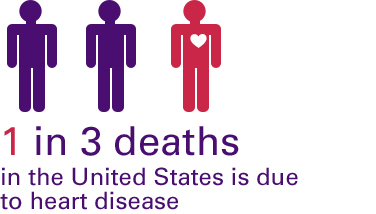MILLION HEARTS. About Heart Disease & Stroke.
Sections for Million Hearts
- WHAT IS MILLION HEARTS? About the Campaign.
- MILLION HEARTS. About Heart Disease & Stroke.
- MILLION HEARTS. Be One in a Million Hearts.
MILLION HEARTS. About Heart Disease & Stroke.
 WHO IS AT RISK?
WHO IS AT RISK?
Heart disease, including heart attack and stroke, affect people of all ages, genders, races, and ethnicities. However, some groups are at higher risk. With more than 2 million heart attacks and strokes happening every year in the United States, it’s important to know the risks.
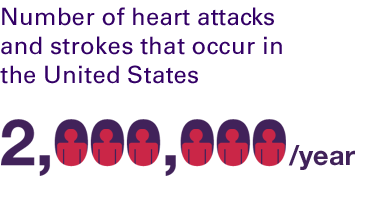
Heart Disease and Age
Many people mistakenly think of heart disease and stroke as conditions that only affect older adults. However, a large number of younger people suffer heart attacks and strokes. More than 150,000 heart disease and stroke deaths every year are among people younger than 65.
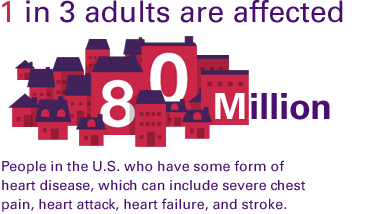
Heart Disease and Race
Heart disease remains the leading cause of death in the United States for adults of all races. However, there are big differences in the rates of heart disease and stroke between different racial and ethnic groups. Minority groups are more likely to be affected by heart disease and stroke than others—which contributes to lower life expectancy found among minorities.
As of 2007, African American men were 30% more likely to die from heart disease than were non-Hispanic white men. African American adults of both genders are 40% more likely to have high blood pressure and 10% less likely than their white counterparts to have their blood pressure under control. African Americans also have the highest rate of high blood pressure of all population groups, and they tend to develop it earlier in life than others.
Heart Disease and Gender
Women in the United States experience higher rates of heart disease than men. Heart disease is the leading cause of death for American women, killing nearly 422,000 each year. Following a heart attack, approximately 1 in 4 women will die within the first year, compared to 1 in 5 men.
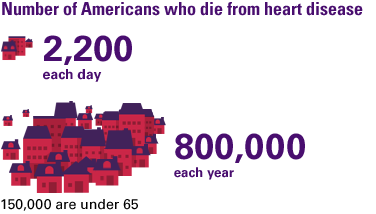
Heart Disease and Income
Men and women of all economic backgrounds are at risk for heart disease and stroke. However, there is a significant difference in the rates of heart disease between high- and low-income groups. Individuals with low incomes are much more likely to suffer from high blood pressure, high cholesterol, heart attack, and stroke than their high-income peers.
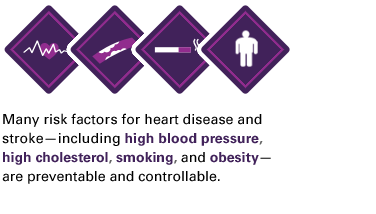
 PREVENTION
PREVENTION
Heart disease and stroke are an epidemic in the United States today. The good news is that many of the major risk factors for these conditions can be prevented and controlled.
Remember Your ABCS
Keep the ABCS in mind every day and especially when you talk to your doctor:
- Appropriate Aspirin Therapy
- Blood Pressure Control
- Cholesterol Control
- Smoking Cessation
Talk to Your Doctor
Share your health history, get your blood pressure and cholesterol checked, and ask if taking an aspirin each day is right for you.
Control Your Blood Pressure and Cholesterol
High blood pressure is one of the leading causes of heart disease and stroke. One in 3 U.S. adults has high blood pressure, and half of these individuals do not have their condition under control.
Similarly, high cholesterol affects 1 in 3 American adults, and two-thirds of these individuals do not have the condition under control. Half of adults with high cholesterol do not get treatment.
If your blood pressure or cholesterol is high, take steps to lower it. This could include eating a healthier diet, getting more exercise, and following your doctor’s instructions about medications you take.
Eat Healthy for Your Heart
What you eat has a big impact on your heart health. When planning your meals and snacks, try to:
- Eat lots of fresh fruits and vegetables.
- Check the labels on your food and select those with the lowest sodium. Too much sodium can increase your blood pressure.
- Limit foods with high amounts of saturated fat, trans fat, and cholesterol. You can find this information on the Nutrition Facts label.
- Cook at home whenever possible. This way, you’re in charge of the ingredients and you know exactly what you and your family are eating.
Get Moving
Obesity can increase your risk for heart disease and stroke. To keep your body at a healthy weight and to fight high blood pressure and cholesterol, make physical activity part of your daily routine. Try to fit in 30 minutes of moderate-intensity exercise on most days of the week. For example, you could take a brisk 10-minute walk 3 times a day, 5 days a week.
Quit Smoking
Cigarette smoking greatly increases your risk for heart disease. If you’re a smoker, quit as soon as possible, and if you don’t smoke, don’t start. You can also support smoke-free policies in your community and try to avoid secondhand smoke.
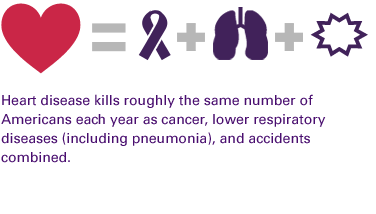
 FREQUENTLY ASKED QUESTIONS
FREQUENTLY ASKED QUESTIONS
What is heart disease? What causes it?
Heart disease refers to several types of heart conditions. The most common type in the United States is coronary artery disease, which can cause heart attack, severe chest pain, heart failure, and irregular heartbeat. Several factors contribute to heart disease, including genetics, high blood pressure and cholesterol, and lifestyle factors such as smoking, unhealthy diet, and lack of exercise.
What is stroke? What causes it?
Stroke is a brain attack that occurs when blood flow to the brain becomes blocked. This can be caused either by a blood clot or by a burst blood vessel in or around the brain. Lack of blood flow during stroke can cause portions of the brain to become damaged, often beyond repair.
What is cardiovascular disease? Is it the same as heart disease?
Cardiovascular disease is a broad term for all diseases that affect the heart or blood vessels. This includes heart attack and stroke as well as conditions such as high blood pressure, coronary artery disease, and aortic aneurism.
How many people die from cardiovascular disease each year?
Cardiovascular disease—including heart disease and stroke—is the leading cause of death in the United States. Every day, 2,200 people die from cardiovascular disease—that’s 815,000 Americans each year, or 1 in every 3 deaths.
How many people have a heart attack or stroke each year?
Americans suffer more than 2 million heart attacks and strokes each year.
Are heart disease and stroke always deadly? What are the other consequences?
Heart disease and stroke are not always fatal, but they can result in serious illness, disability, and decreased quality of life. Suffering a stroke may lead to significant disability, such as paralysis, speech difficulties, and emotional problems. Following a heart attack, individuals frequently suffer fatigue and depression, and they may find it more difficult to engage in physical activities. Heart disease and stroke are among the leading causes of disability in the United States, with more than 3 million people reporting disability from these causes.
Are heart disease and stroke preventable?
Many major risk factors—including blood pressure, cholesterol, smoking, and obesity—are controllable. Eating a healthy diet, exercising regularly, not smoking, and limiting alcohol use are all important steps toward preventing heart disease and stroke.
What are the barriers to effective heart disease and stroke prevention?
Many people with key risk factors for heart disease and stroke—such as high blood pressure and high cholesterol—are not aware that they have these conditions, or are not aware that their high blood pressure or cholesterol needs to be more effectively controlled. Other barriers include:
- Access to health care
- Continuity of care
- Inadequate time with patients
- Medication adherence and side effects
- Reimbursement systems
- Fragmented systems of health care
What age groups do heart disease and stroke affect?
Heart disease and stroke affect all age groups, not just older adults. More than 150,000 heart disease and stroke deaths annually are among people younger than 65.
Do heart disease and stroke affect all races and ethnicities equally?
Heart disease and stroke disproportionately impact minority and low-income populations, contributing to significant differences in life expectancy.
In 2007, African American men were 30% more likely to die from heart disease, compared to non-Hispanic white men.
African Americans also have the highest rate of high blood pressure of all population groups and tend to develop it younger than others. African American adults are 40% more likely to have high blood pressure, but 10% less likely than white individuals to have their blood pressure under control.
Disparities in rates of cardiovascular disease risks and outcomes also exist between high- and low-income groups. This discrepancy is due to numerous factors, including early life environment, quality of health education, availability of nutritious food, proximity to recreational facilities, cultural and financial barriers to seeking treatment, and accessibility of cardiovascular care.
Do heart disease and stroke affect men and women equally?
Cardiovascular disease kills more women than men each year and is the leading cause of death for American women, claiming the lives of nearly 422,000 women each year. About 1 in 4 women will die within one year of a first heart attack; the same is true for nearly 1 in 5 men.
How much do heart disease and stroke cost the United States?
Together, heart disease and stroke are among the most widespread and costly health problems facing the nation today, accounting for more than $444 billion in health care expenditures and lost productivity in 2010 alone—and these costs are rising. On a personal level, families who experience heart disease or stroke not only have to deal with medical bills but also lost wages and the real potential of a decreased standard of living.
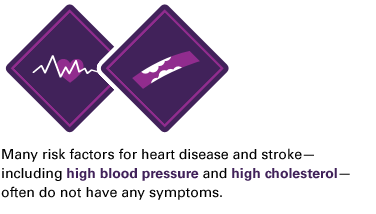
…
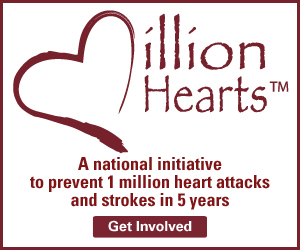
…

